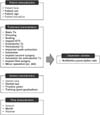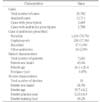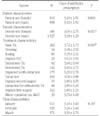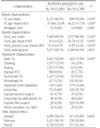Abstract
Objectives
Resistance to antibiotics is getting worse every day. Antibiotics are commonly prescribed medicines for the prevention and treatment of bacterial infections in dental clinics. Nationally, we are attempting to reduce the use of antibiotics, but this cannot be easily achieved. As a precedent study, we investigated factors affecting antibiotic prescription in dental clinics.
Methods
We analyzed electronic patient records of S dental hospital located in a big city. A total of 12,711 medical records were analyzed. The type of prescribed antibiotic, the prescription rate, and the number of prescription days were analyzed by chi-square test and t-test. Factors associated with the rate of antibiotic prescription were analyzed using logistic regression by dividing the independent variables into four groups: patient characteristics, dentist characteristics, treatment characteristics, and time characteristics.
Results
The rate of antibiotic prescription was 91.7% for the first implant surgery and 60.0% for minor operations including incision and drainage. The duration of antibiotic prescription differed according to the sex of the dentist and the type of treatment. The logistic regression analysis showed that the rate of antibiotic prescription was higher in male patients, in older patients, and in female dentists, and decreased with increasing age of the dentist. Compared with basic treatment, the odds ratio of first implant surgery was highest at 102.166 times, minor operation at 18.997, and extraction of impacted tooth at 14.429.
Conclusions
This is the first study to analyze the factors affecting prescription rate of antibiotics in dental clinics. We found that the antibiotic prescription rate was significantly different for each dental treatment. It was necessary to analyze the prescription rate of antibiotics according to the type of treatment. The fact that prescribing antibiotics differed according to dentist characteristics indicated that consistent guidelines need to be established and promoted.
Figures and Tables
 | Fig. 1Conceptual framework for the antibiotics prescription rate; bold letters mean selected variables for the regression analysis. |
References
1. Baek JH. The Main Considerations for Antibiotic Therapy in Dental Office. J Korean Dent Assoc. 2013; 51:148–155.
2. Lewis MA. Why we must reduce dental prescription of antibiotics: European Union Antibiotic Awareness Day. Br Dent J. 2008; 205:537–538.

4. Kim SS, Moon SM, Kim EJ. Public knowledge and attitudes regarding antibiotic use in South Korea. J Korean Acad Nurs. 2011; 41:742–749.

5. Kim SK, Kim HE, Back MS, Lee SH. The Effect of Public Report on Antibiotics Prescribing Rate. Korean J Clin Pharm. 2010; 20:242–247.
6. Song YK, Lee HK, Ji EH, Oh JM. Patterns of Antibiotic Usage in Clinics and Pharmacy after Separation of Dispensary from Medical Practice. Korean J Clin Pharm. 2011; 21:332–338.
7. Dar-Odeh NS, Abu Hammad OA, Al Omiri MK, Khraisat AS, Shehabi AA. Antibiotic prescribing practices by dentists: a review. Ther Clin Risk Manag. 2010; 6:301–306.

8. Sakong P, Lee JS, Lee EJ, Ko KP, Kim CH, Kim Y, et al. Association between the pattern of prophylactic antibiotic use and surgical site infection rate for major surgeries in Korea. J Prev Med Public Health. 2009; 42:12–20.

9. Monaco G, Staffolani C, Gatto MR, Checchi L. Antibiotic therapy in impacted third molar surgery. Eur J Oral Sci. 1999; 107:437–441.

10. Jang SJ, Lee YG, Ahn Y, Leem DH, Baek JA, Shin HK. A Clinicostastical Study Of Oral And Maxillofacial Infected Patients For The Last 5 Years. J Korean Assoc Oral Maxillofac Surg. 2006; 32:401–409.
11. Haffajee AD, Socransky SS, Gunsolley JC. Systemic anti-infective periodontal therapy. A systematic review. Ann Periodontol. 2003; 8:115–181.

12. Palmer NO, Martin MV, Pealing R, Ireland RS. An analysis of antibiotic prescriptions from general dental practitioners in England. J Antimicrob Chemother. 2000; 46:1033–1035.

13. Caton JG, Ciancio SG, Blieden TM, Bradshaw M, Crout RJ, Hefti AF, et al. Treatment with subantimicrobial dose doxycycline improves the efficacy of scaling and root planing in patients with adult periodontitis. J Periodontol. 2000; 71:521–532.

14. Jo CI, Lim JY, Lee SY. The Effect of the Degree of Competition of the Hospital Market Regions on Clinic’s Rate of Antibiotics Prescription. KDI J Econ Policy. 2008; 30:129–155.

15. Wensing M, van der Weijden T, Grol R. Implementing guidelines and innovations in general practice: which interventions are effective? Br J Gen Pract. 1998; 48:991–997.
16. Cho HA, Kim SM, Shin HS. Drug prescription rates in dental health services. J Korean Acad Oral Health. 2014; 38:212–219.

17. Choi WJ, Yim ES, Kim TH, Suh HS, Choi KC, Chung W. Analysis of Factors Related to the Prescription of Antibiotics for the Acute Upper Respiratory Infection. Health Policy Manag. 2015; 25:256–263.

18. van der Velden AW, Pijpers EJ, Kuyvenhoven MM, Tonkin Crine SK, Little P, Verheij TJ. Effectiveness of physician-targeted interventions to improve antibiotic use for respiratory tract infections. Br J Gen Pract. 2012; 62:e801–e807.

19. Wilson W, Taubert KA, Gewitz M, Lockhart PB, Baddour LM, Levison M, et al. Prevention of Infective Endocarditis Guidelines From the American Heart Association: A Guideline From the American Heart Association Rheumatic Fever, Endocarditis, and Kawasaki Disease Committee, Council on Cardiovascular Disease in the Young, and the Council on Clinical Cardiology, Council on Cardiovascular Surgery and Anesthesia, and the Quality of Care and Outcomes Research Interdisciplinary Working Group. Circulation. 2007; 116:1736–1754.
20. Thomas Z, Bandali F, Sankaranarayanan J, Reardon T, Olsen KM; Network CCPT. A multicenter evaluation of prolonged empiric antibiotic therapy in adult ICUs in the United States. Crit Care Med. 2015; 43:2527–2534.

21. Gong MJ. Clinical department prescription drugs characteristics of Acute upper respiratory tract infection disease [Master's thesis]. Pusan: Catholic University;2016. [Korean].
22. Schuler CL, Courter JD, Conneely SE, Frost MA, Sherenian MG, Shah SS, et al. Decreasing Duration of Antibiotic Prescribing for Uncomplicated Skin and Soft Tissue Infections. Pediatrics. 2016; 137:e20151223.

23. Kanuga S. Short-term oral antibiotics may be as effective as the standard course of penicillin for children with acute streptococcal pharyngitis. J Am Dent Assoc. 2015; 146:927–928.

24. El Moussaoui R, De Borgie CA, Van den Broek P, Hustinx WN, Bresser P, Van den Berk GE, et al. Effectiveness of discontinuing antibiotic treatment after three days versus eight days in mild to moderate-severe community acquired pneumonia: randomised, double blind study. BMJ. 2006; 332:1355.

25. Pugh R, Grant C, Cooke RP, Dempsey G. Short-course versus prolonged-course antibiotic therapy for hospital-acquired pneumonia in critically ill adults. Cochrane Database Syst Rev. 2011; (10):

26. Cotter PD, Stanton C, Ross RP, Hill C. The impact of antibiotics on the gut microbiota as revealed by high throughput DNA sequencing. Discov Med. 2012; 13:193–199.
27. Gelbrand H, Miller-Petrie M, Pant S, Gandra S, Levinson J, Barter D, et al. The State of the World's Antibiotics 2015. Wound Heal South Afr. 2015; 8:30–34.




 PDF
PDF ePub
ePub Citation
Citation Print
Print







 XML Download
XML Download